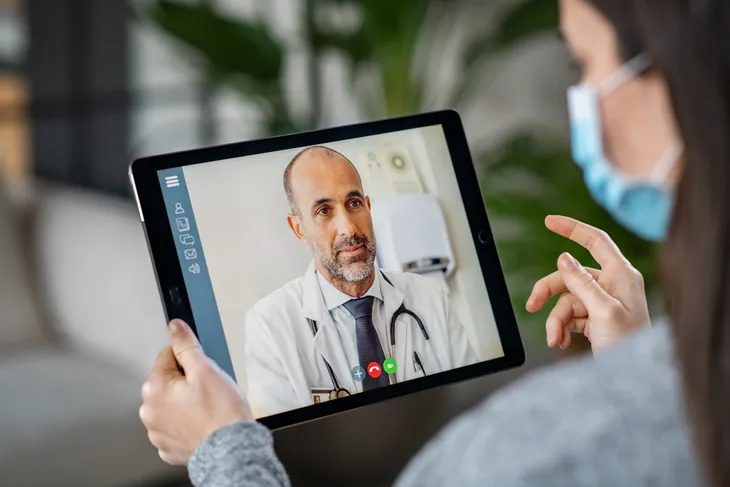Telehealth services are booming and it’s easy to see why. For starters, you don’t have to commute to a doctor’s office or wait in a waiting room when you’re sick. There’s also a lot of availability and it’s often more affordable compared to in-person care. But with so many telemedicine companies available, choosing the right one can be a challenge.
The best telemedicine provider for you will vary depending on your budget, current needs, and level of urgency. To help, here’s a look at the 6 most reputable telemedicine companies in the U.S. in 2023.
Best Overall: Sesame Care
Sesame Care continues to be one of the best telemedicine companies in the U.S. Sesame offers affordable direct-to-patient doctor appointments starting at $39 USD per visit for non-members. Or, you can save money by opting for a monthly membership fee of $10.99 per month or $99 per year, which drops your appointment cost to about $19 per visit.
A Sesame Plus membership also saves you $20 to $30 off non-member appointment pricing and it covers primary care, telehealth, specialties, dentists, labs, imaging, and more. Whether you choose to be a member or not, you can search for doctors, nurse practitioners, and dentists based on your needs, budget, and schedule. Each professional also has a profile where you can see their credentials, years of service, education, and training to ensure they’re reputable and a good fit for you.
Budget-Friendly: PlushCare
PlushCare is a very affordable telemedicine company, costing about $14.99 USD a month or $99 per year for a membership. Self-pay is also an option and patients can expect to pay $129 for a new visit and $69 for follow-ups.
Plushcare offers a variety of services from primary care and urgent care to online prescriptions and mental health services. Members will also get unlimited in-app messaging to their care team if they need support or information. They also offer same-day appointments and can typically provide healthcare advice from a board-certified doctor within 15-minutes of your request. Still not sold? Plushcare also offers a 30-day free trial, so you can make sure it’s a good fit for you!
 sattahipbeach / Shutterstock
sattahipbeach / ShutterstockBest Non-Urgent Care: Teladoc
Teladoc is one of the first telemedicine companies in the U.S., dating back to 2002. As such, they’re a major player in the telehealth space and very popular among Americans.
Teladoc can be used for a range of medical concerns from primary care and non-emergency medical concerns to pediatric care and mental health consultations. Another major benefit of Teladoc is that its site is easy to navigate. If you have health insurance and Teladoc is covered under your plan, your visits may be as low as $0. If you don’t have insurance, general medical visits are about $75 USD per visit.
Most Affordable: GoodRx Care
You may know GoodRx, which is a service that offers current prices and discounts to help you find the cheapest pharmacy for your prescriptions. But did you know they also have a telemedicine service? GoodRx Care offers a variety of medical services from general health and preventive care to prescription refills and more. And it’s rated as one of the most affordable telemedicine companies in the U.S.
What’s more, you can also receive discounted prescriptions when using GoodRx coupons. Medical visits cost as low as $19 USD with a gold membership, which is $9.99 per month. Without a membership, most visits start at $49. Another benefit is you don’t need insurance to access care, and they’ll always inform you of the price before your visit so there are no hidden fees.
Best With Insurance: MDLive
MDLive is rated as one of the best telemedicine companies for people with health insurance. MBG Health states that more than 60 million people already have MDLive included in their health insurance plans, but it’s a good idea to double-check with your provider. MDLive covers a wide range of conditions from primary care and urgent care to dermatology and mental health.
Depending on your insurance coverage, some appointments may cost as little as $0 and Healthline says an urgent care visit can be as low as $82 USD. If you don’t have insurance you can still receive care, MDLive will simply show you the cost of the appointment before it begins.
Another major benefit to MDLive is physicians and other healthcare professionals are available by phone or video conferencing 24-hours a day for non-emergency questions about medical conditions, such as allergies, headaches, rashes, fever, and more.
Best for Mental Health: BetterHelp
Most telemedicine companies offer mental health benefits but the biggest benefit to BetterHelp is they specialize in mental health treatment. BetterHelp’s network consists of licensed, accredited, and experienced therapists who can help treat a range of issues from depression and anxiety to relationships, trauma, grief, and more. They also offer therapy for individuals, couples, and teens.
Based on your personal needs, BetterHelp will pair you with a licensed and credentialed therapist. Though you can’t choose your therapist, you can switch at any time. Communication is done through messages, live chatting, phone calls, or video conferencing — your choice! Another benefit is you can message your therapist at any time. The cost of therapy ranges from $60 to $90 USD per session, which is billed every four weeks. Also, keep in mind you can cancel your membership at any time, for any reason.








